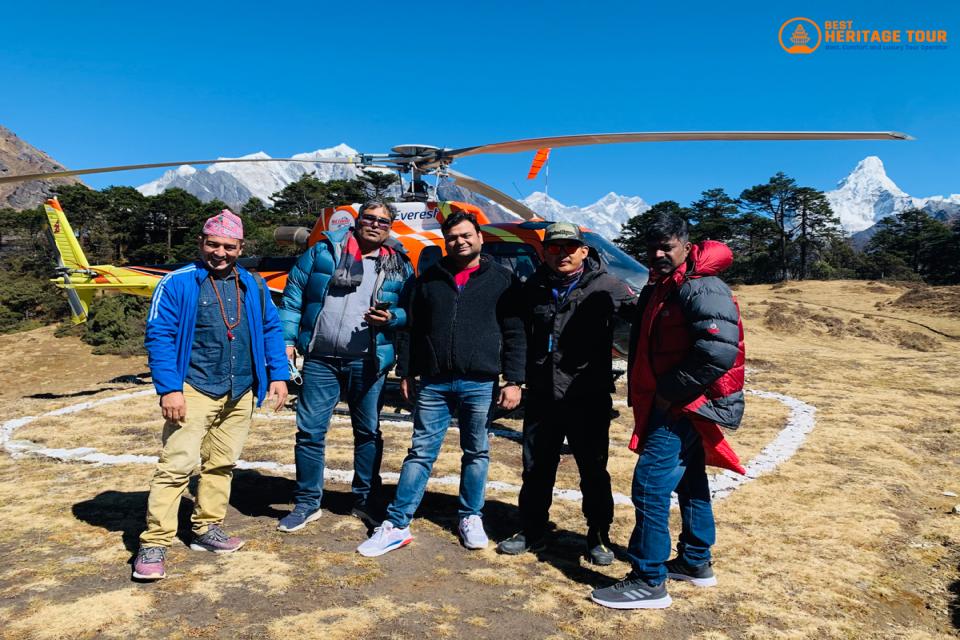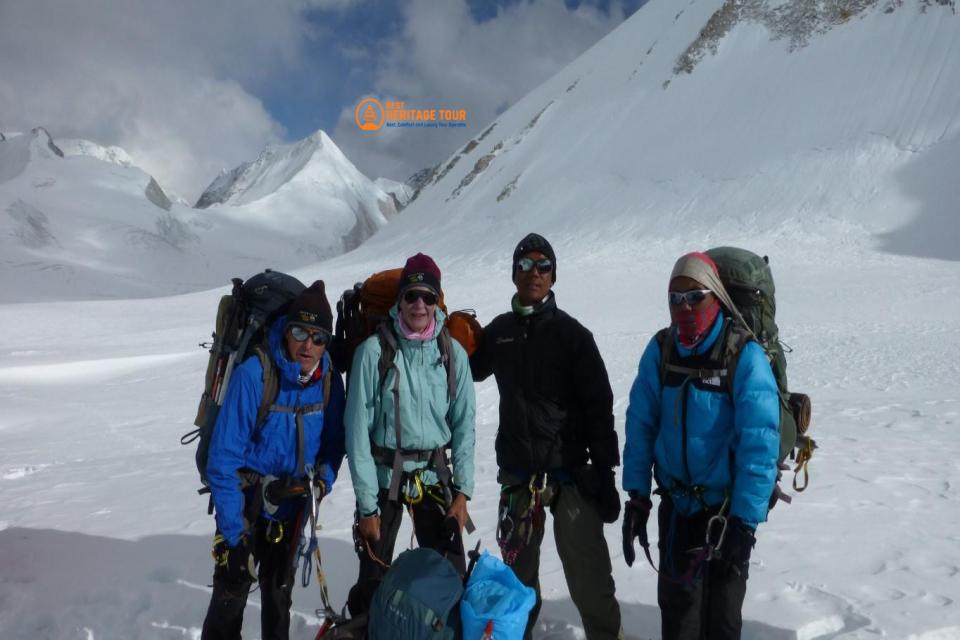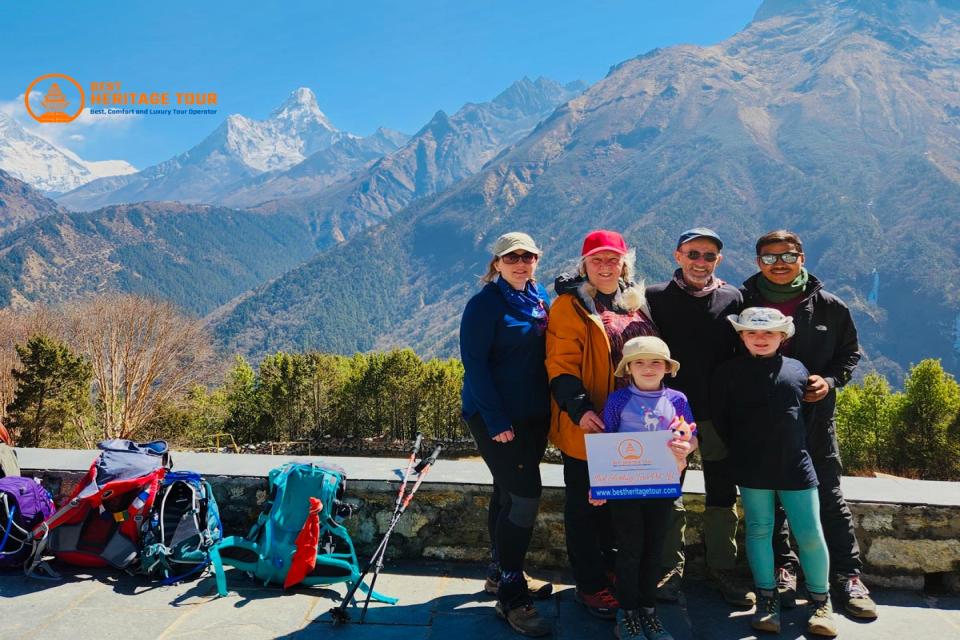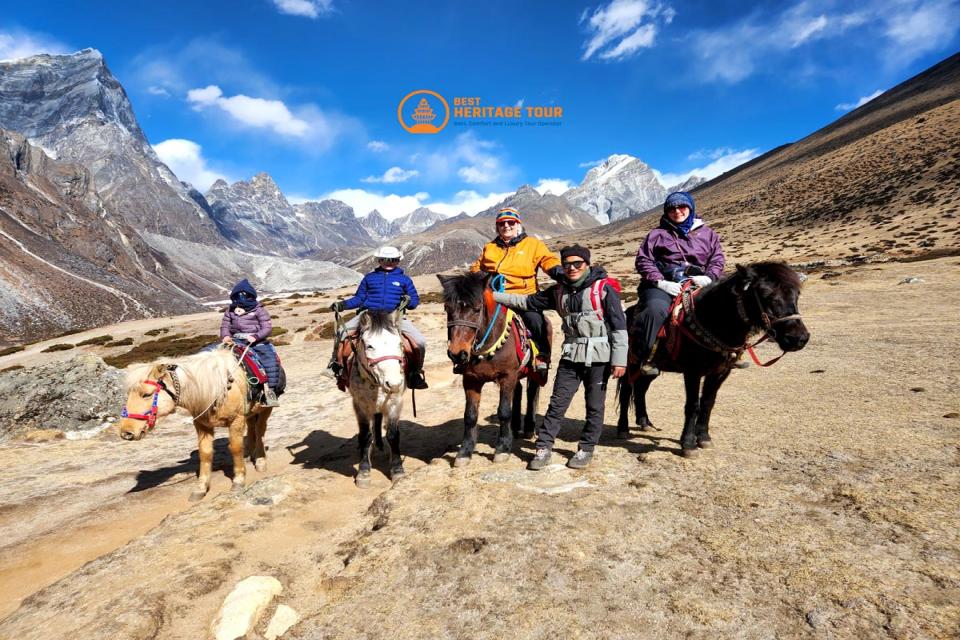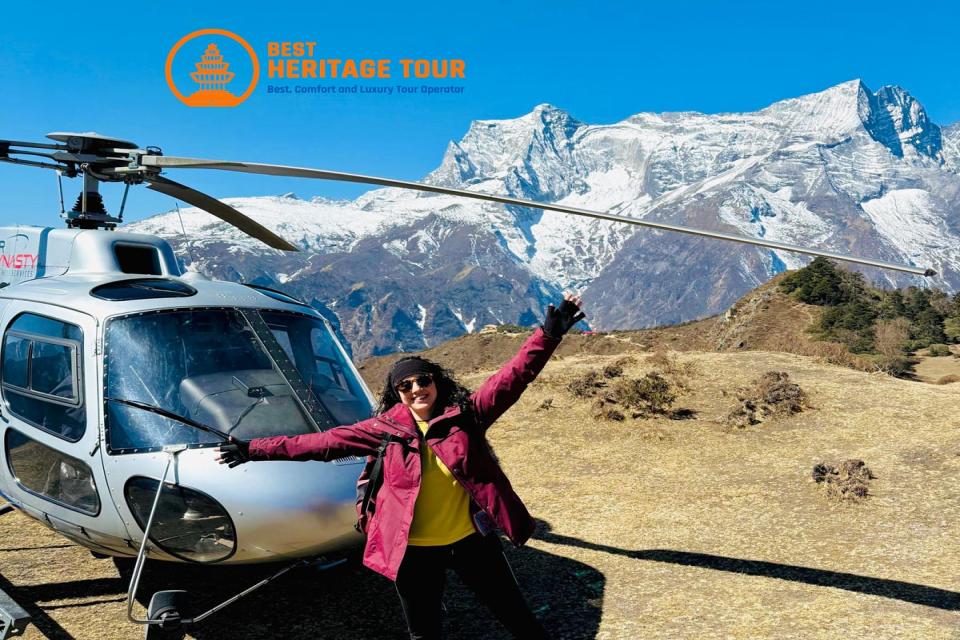The Everest Base Camp (EBC) trek is a pilgrimage to the foot of the world’s highest peak and an unparalleled personal challenge. The single most critical factor determining your success, safety, and enjoyment is the Everest Base Camp Trek weather.
The Himalayas are a land of extremes. The climate along the EBC trek route changes dramatically due to the massive altitude variation - from sub-tropical near Lukla (2,860m) to arctic at Base Camp (5,364m). For trekkers planning their journey in 2026, understanding this Khumbu Region climate by month is the cornerstone of preparation.
At Best Heritage Tour, we provide the insight gained from decades of experience. This in-depth guide is designed to inform and educate, ensuring you select the Best Time to Trek EBC that perfectly matches your personal goals.
We will break down all four trekking seasons with a detailed, month-by-month analysis of temperature, precipitation, visibility, and crowd levels.
The Four Seasons of Everest: Overview of the Khumbu Climate
|
Season |
Months |
Weather Summary |
Visibility/Views |
Crowd Level |
|---|---|---|---|---|
|
Autumn (Post-Monsoon) |
September, October, November |
Stable, clear, dry, perfect. |
Excellent/Crystal Clear |
Highest (Peak Season) |
|
Winter |
December, January, February |
Extremely cold, high chance of snow. |
Excellent, very clear air. |
Lowest (Off-Season) |
|
Spring (Pre-Monsoon) |
March, April, May |
Stable, mild, warm lower down. |
Very Good (Best in March/April) |
High (Peak Season) |
|
Monsoon (Summer) |
June, July, August |
Warm, wet, cloudy, muddy trails. |
Poor (Limited/Occasional Views) |
Very Low (Off-Season) |
1. Peak Season Perfection: Autumn (September, October, November)
Autumn is overwhelmingly considered the Best Time to Trek EBC. The monsoon rains have washed the air clean, offering spectacular mountain visibility, dry trails, and moderate temperatures.
September: The Post-Monsoon Transition
-
Weather: Early September can see light rainfall, but the weather stabilizes quickly by mid-month. The crisp, clear skies of autumn begin.
-
Everest Base Camp Temperature: Daytime highs range from 12°C (lower) to 5°C (higher). Nights drop to 0°C to -5°C.
-
Crowd: Moderate, increasing rapidly.
-
Best For: Trekkers who want clear skies but prefer to beat the massive crowds of October.
October: The Golden Month
-
Weather: October is the golden month. Weather is at its most stable, dry, and predictable. Clear blue skies are the norm.
-
Everest Base Camp Temperature: Comfortable daytime highs (0°C to 5°C at Base Camp elevation). Nights are cold but manageable: -5°C to -10°C.
-
Visibility: Excellent. Provides the most reliable and spectacular photographic views.
-
Crowd: Highest. Book flights and lodges well in advance.
-
Best For: First-time trekkers who prioritise the absolute best weather and mountain views.
November: Crisp, Clear, and Cold
-
Weather: Excellent conditions continue, but the temperature drops significantly. Air is crisp and dry.
-
Everest Base Camp Temperature: Midday -5°C in high camps, with night temperatures plummeting to -10°C to -15°C.
-
Crowd: High, thinning out towards the end of the month.
-
Best For: Trekkers who tolerate colder temperatures for outstanding clarity and slightly less congested trails than October.
2. The Challenging Seasons: Winter (December, January, February)
Winter trekking is for the adventurous. While days are often bright and clear, the extreme cold poses a serious challenge, especially at night.
December: Early Winter's Beauty
-
Weather: Early December offers clear skies and manageable cold. By late December, the deep cold sets in.
-
Everest Base Camp Temperature: Daytime around 0°C at high altitudes. Nights drop to -15°C to -20°C.
-
Crowd: Low.
-
Key Consideration: Lukla Flight Delays are more common due to morning fog.
January: The Deep Freeze
-
Weather: January is the coldest month. Snowfall is common at higher altitudes, but days are often sunny.
-
Everest Base Camp Temperature: Daytime: -5°C to -15°C. Nighttime: Plunging to -20°C to -25°C and lower.
-
Crowd: Lowest.
-
Essential Gear: A world-class sleeping bag (rated for at least -20°C) and down jacket are non-negotiable.
February: The Turnaround
-
Weather: Remains extremely cold, but daylight hours lengthen, and a slow warming trend begins toward the end of the month.
-
Everest Base Camp Temperature: Slightly warmer than January. Daytime: -3°C to 5°C. Nighttime: -15°C to -20°C.
-
Crowd: Very Low, increasing slightly late in the month.
-
Best For: Experienced winter trekkers seeking solitude and clear, snowy views.
3. Peak Season Reborn: Spring (March, April, May)
Spring is the second most popular season. The snow melts, rhododendron forests bloom, and temperatures become milder, though late spring can be hazy.
March: The Spring Awakening
-
Weather: The true end of winter. Trails are mostly clear of snow, and daytime temperatures become comfortable. Nights remain very cold early on.
-
Everest Base Camp Temperature: Daytime 0°C to 10°C. Nighttime: -10°C to -15°C.
-
Crowd: Moderate, increasing throughout the month.
-
Highlight: The lower trails begin to see the first rhododendron blooms.
April: The Perfect Trekking Window
-
Weather: Another of the Best Time to Trek EBC months. Temperatures are mild and stable, and the weather is generally dry. Prime season for mountaineering expeditions.
-
Everest Base Camp Temperature: Pleasant daytime highs (5°C to 15°C). Manageable nighttime lows (-5°C to -10°C).
-
Crowd: High. Book your Best Heritage Tour package well in advance.
-
Highlight: The Khumbu valley is beautiful, carpeted in colourful rhododendrons.
May: Pre-Monsoon Warmth and Haze
-
Weather: Warmest month before the monsoon. Lower altitudes can feel hot. Cloud cover and haze start building up in the afternoons, potentially obscuring views.
-
Everest Base Camp Temperature: Daytime: 0°C to 10°C (higher). Nights are the warmest of the year.
-
Visibility: Moderate to Fair. Good views in the mornings.
-
Crowd: High, slightly decreasing towards the end of May.
-
Key Consideration: Start your trek early to finish before the afternoon haze sets in.
4. Monsoon Season: Summer (June, July, August)
The off-peak season. Temperatures are warm, but heavy rainfall and cloud cover present unique challenges, primarily muddy trails and unpredictable flight delays.
June: The Onset of Rain
-
Weather: Monsoon arrives in early June. Expect regular, often heavy rainfall.
-
Everest Base Camp Temperature: Warmest overall temperatures. Nights are mild, often above freezing.
-
Visibility: Poor and unpredictable. Clouds can cover the high peaks for days.
-
Key Challenge: High risk of Lukla Flight Delays and cancellations due to heavy cloud cover.
July: Wettest Month
-
Weather: The height of the monsoon, with the highest precipitation levels. Trekking requires high-quality waterproof gear.
-
Visibility: Poor. Mountain views are often limited to brief breaks in the clouds.
-
The Silver Lining: The landscape is intensely green, lush, and full of swollen waterfalls - a unique beauty.
August: End of the Rain
-
Weather: Rainfall eases toward the end of August. Conditions are warm, humid, and cloudy.
-
Visibility: Poor, but improving slightly toward late August.
-
Best For: Budget travellers and solitude seekers who are unbothered by rain and delays. Flexibility is paramount.
The Science of High Altitude: Gear and Logistics
Your success on the EBC Trek hinges on acknowledging the extreme conditions and preparing for them using proper High Altitude Trekking Gear.
The Layering Strategy
Due to the massive temperature drops between day and night, and low and high altitude, the strategy is always layering.
-
Base Layer: Merino wool or synthetic thermals to wick moisture away.
-
Mid-Layer: Fleece or insulating vest to retain body heat.
-
Outer Layer: A high-quality, windproof and waterproof (or highly water-resistant) outer shell or 800-fill down jacket. Essential for the biting winds at higher altitudes.
Lukla Flights and Weather Delays
Flights into Lukla's Tenzing-Hillary Airport are a logistical hurdle. Lukla Flight Delays are common and are almost always weather-related.
-
Best Heritage Tour Expert Tip: Delays are most common during the monsoon (June-August) and in the mornings of deep winter (January-February). If trekking during these times, always build a minimum of 2-3 contingency days into your overall itinerary.
Acclimatization and Safety
The cold, dry air at high altitude can lead to the "Khumbu cough." Always wear a buff or mask over your mouth and nose to warm the air you breathe. Never rush your ascent; the gradual pace planned by Best Heritage Tour is the best defense against altitude sickness.
EBC Trek Monthly Weather Summary for 2026
For quick reference, here is the final takeaway on weather for the EBC Trek Monthly Guide 2026:
|
Month |
Day Temp (High Camps) |
Night Temp (High Camps) |
Visibility/Views |
Trekker Traffic |
Best For |
|---|---|---|---|---|---|
|
January |
-15°C to -5°C |
-25°C |
Excellent |
Very Low (Quietest) |
Experienced, Cold-Tolerant |
|
February |
-12°C to 0°C |
-20°C |
Excellent |
Very Low |
Solitude, slightly longer days |
|
March |
-5°C to 5°C |
-15°C to -10°C |
Very Good |
Moderate |
Great balance, beginning of the bloom |
|
April |
0°C to 10°C |
-10°C to -5°C |
Excellent |
High (Peak) |
Ideal weather, rhododendrons, expeditions |
|
May |
5°C to 15°C |
-5°C to 0°C |
Good (Hazy afternoons) |
High |
Warmest days, pre-monsoon warmth |
|
June |
10°C to 20°C |
0°C to 5°C |
Poor (Rain/Cloud) |
Very Low |
Quiet trails, prepared off-season |
|
July |
10°C to 20°C |
5°C to 10°C |
Poor (Heavy Rain/Cloud) |
Very Low (Wettest) |
Budget, nature lovers, extreme solitude |
|
August |
10°C to 20°C |
5°C to 10°C |
Poor (Improving late month) |
Very Low |
Quiet trails, preparing for clear season |
|
September |
5°C to 15°C |
0°C to -5°C |
Good to Excellent |
Moderate (Increasing) |
Best for avoiding the October crowds |
|
October |
0°C to 10°C |
-5°C to -10°C |
Excellent (Clearest) |
Highest (Peak) |
Most stable, clearest skies, perfect conditions |
|
November |
-5°C to 5°C |
-10°C to -15°C |
Excellent |
High (Decreasing) |
Great views for cold-tolerant trekkers |
|
December |
-10°C to 0°C |
-15°C to -20°C |
Excellent |
Low |
Early winter challenge and solitude |
Conclusion: Crafting Your Perfect 2026 EBC Trek
Choosing the right month is the first step toward a successful journey. The second is choosing the right local partner. At Best Heritage Tour, we combine logistical excellence with authentic Nepalese hospitality and deep local knowledge of the Khumbu region's trails and climate patterns. We ensure your itinerary is optimized for acclimatization, safety, and the maximum enjoyment of the spectacular Himalayan views.
Whether you are aiming for the golden skies of October or the peaceful solitude of the shoulder seasons, let us manage the complexities of permits, lodging, and high-altitude safety. Your only job is to train, prepare your gear, and enjoy the Best Heritage Tour experience.
Ready to start planning your Everest Base Camp Trek for 2026?
Contact the Himalayan experts at Best Heritage Tour today for a personalized itinerary that aligns with your chosen month and trekking style.
Phone / WhatsApp / Viber: +977-9851149197 / +977-9810043046
Email: info@bestheritagetour.com / bestheritagetour@gmail.com
Website: www.bestheritagetour.com
Office Address: Thamel Marg, Kathmandu, Nepal
Author: Best Heritage Tour
Date: 23rd November, 2025



